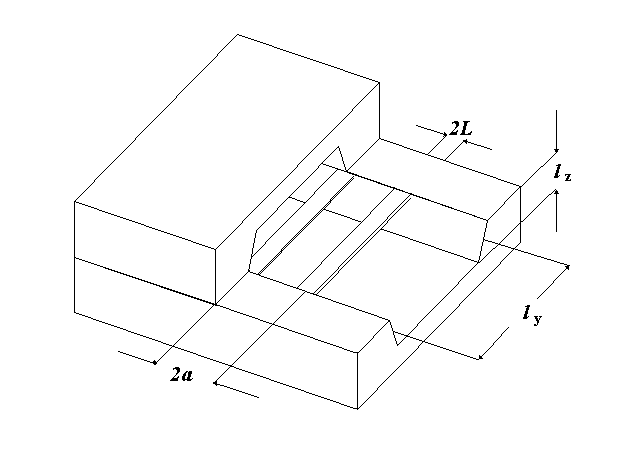Prof. Dr. J. Sennheiser - sennjse@sennheiser.com
Am Labor 1, D-30900 Wedemark, Germany
Tel. #49 5130 600 212, Fax #49 5130 600 456
Popular version of paper 2pEA1
Presented Tuesday afternoon, March 16, 1999
ASA/EAA/DAGA '99 Meeting, Berlin, Germany
On the physical basis of a sensor for measuring flows in gases and fluids, known as an anemometer, the joint efforts of MESA Research Institute at the University of Twente (Netherlands) and Sennheiser Electronic Company in Germany have produced a transducer, sensing the particle flow in an acoustic wave. The advantages of this design are:

Fig. 1: sectional view of the bridge type microflown microphone
lz = 270 m - half the height of the channel
ly = 870 m - medium channel width
L = 5 m - half the width of the sensor
a = 25 m.-.half the distance between the sensors
The most recent design shows two combined heater/resistor platinum beams (10m wide, 150nm high and about 900m long) suspended over a trench of silicon nitride edged away underneath. Platinum was chosen for the resistors because its high temperature coefficient of 3.810-3/K. The frequency response of this acoustic sensor together with a customized electronics shows a frequency response being linear up to 200 Hz, gradually falling with higher frequencies proportional to -6 dB/Oct. Sensitivity can be boosted by mounting the sensor in the middle of a two sided funnel, acting as a velocity transformer to the natural velocity in a sound wave resulting in an increased sensitivity of 10-15 dB.
Performance is close to standard microphones used in telephone sets. Although these results are very promising it now is mandatory to develop a valid theory about the mechanism of the microflown principle in order to further optimize design parameters.
Literature: